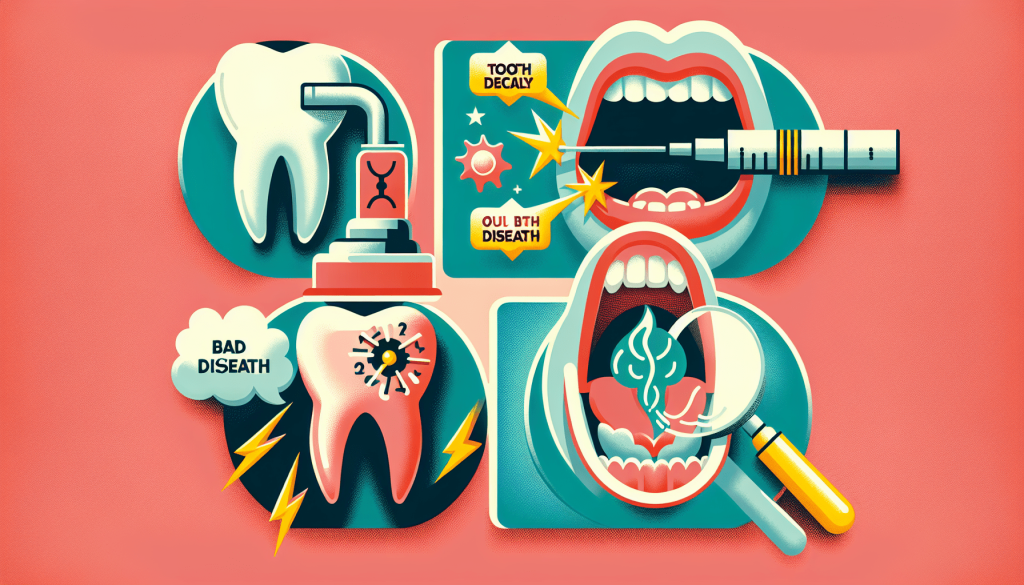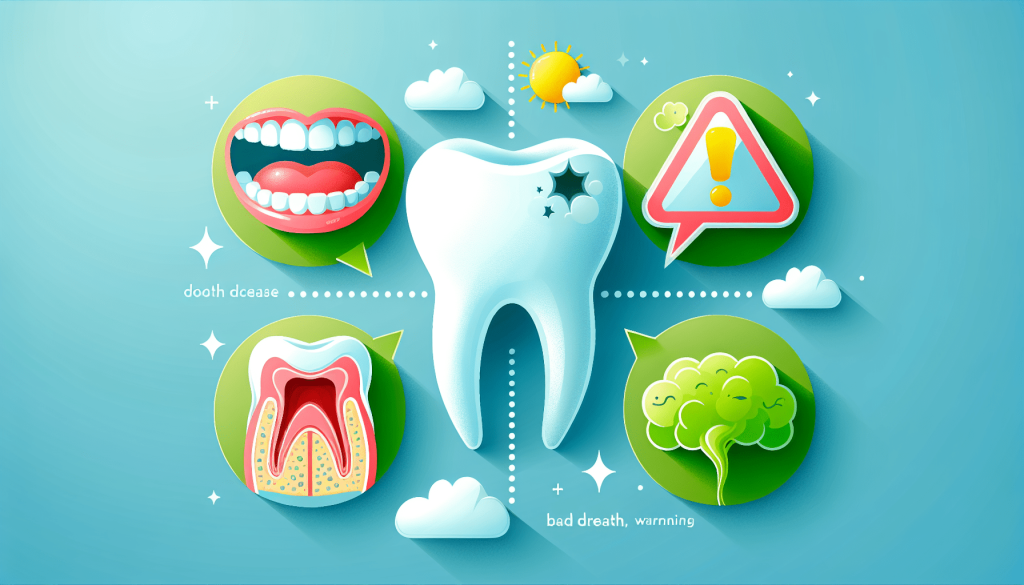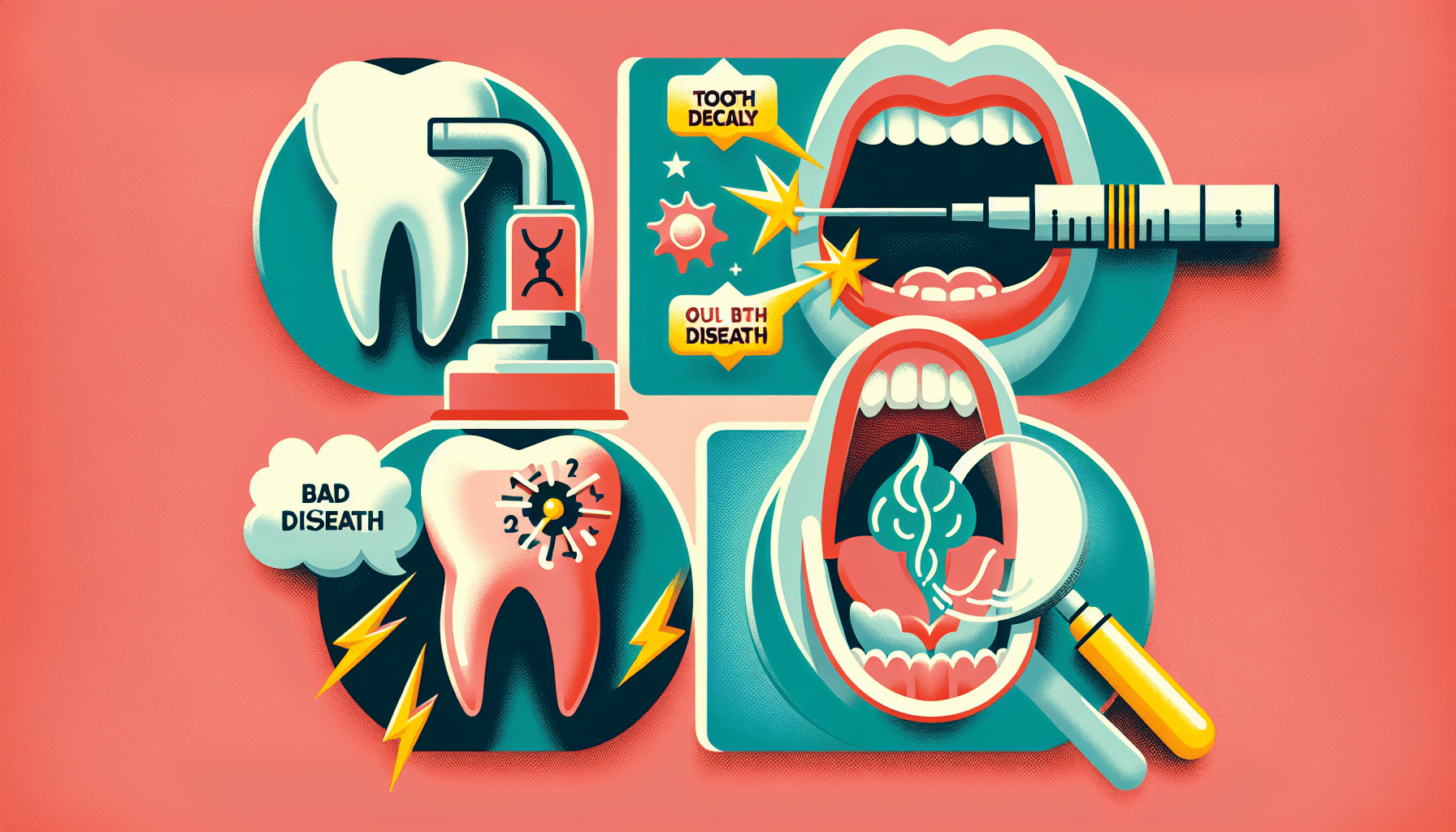What Are The Four Common Oral Problems?
You take great care of your oral health, diligently brushing and flossing every day. But have you ever wondered what are the four most common oral problems that people face? From tooth decay to gum disease, these oral issues can cause discomfort and may even lead to more serious complications if left untreated. In this article, we will explore these four common oral problems and provide you with insights on how to prevent and address them effectively. So, let’s dive right in and discover what these oral problems are and how you can ensure a healthy smile for years to come.
Tooth Decay
Tooth decay, also known as dental caries or cavities, is a common oral problem that affects people of all ages. It occurs when the outer layer of the tooth, known as the enamel, starts to deteriorate due to the acids produced by bacteria in our mouth. Several factors can contribute to tooth decay, such as poor oral hygiene, a diet high in sugar and carbohydrates, dry mouth, and certain medical conditions.
Causes of Tooth Decay
The primary cause of tooth decay is the presence of bacteria in our mouth. When we consume foods and beverages that contain sugar and starches, the bacteria in our mouth feed on these particles and produce acids as a byproduct. Over time, these acids begin to wear away the enamel of our teeth, leading to tooth decay.
Poor oral hygiene practices, such as infrequent brushing and flossing, can also contribute to tooth decay. If we fail to remove the plaque that forms on our teeth regularly, the bacteria in the plaque can attack the enamel and initiate the decay process.
Additionally, individuals with dry mouth conditions, which reduce saliva flow, are at a higher risk of developing tooth decay. Saliva plays a crucial role in neutralizing the acids in our mouth and maintaining a healthy balance. Without enough saliva, the acid levels can increase, causing tooth decay.
Symptoms of Tooth Decay
Recognizing the symptoms of tooth decay is essential for early detection and treatment. Some common signs of tooth decay include:
- Toothache: A persistent or occasional toothache, especially while eating or drinking.
- Tooth Sensitivity: Increased sensitivity to hot, cold, or sweet foods and drinks.
- Visible Holes or Pits: Dark spots or visible holes on the surface of the teeth.
- Discoloration: Discoloration or white, brown, or black spots on the surface of the teeth.
- Bad Breath: Persistent bad breath that does not improve with oral hygiene practices.
- Swelling or Pus: Swelling or pus around the affected tooth, indicating an infection.
If you experience any of these symptoms, it is crucial to visit your dentist for a thorough examination and appropriate treatment.
Prevention and Treatment
Preventing tooth decay starts with maintaining good oral hygiene practices. Brushing your teeth at least twice a day with fluoride toothpaste and flossing daily can help remove plaque and bacteria from the surface of your teeth. Additionally, using an antimicrobial mouthwash can further reduce the bacterial load in your mouth.
Avoiding excessive consumption of sugary and acidic foods and drinks can also help prevent tooth decay. Instead, opt for a balanced diet rich in fruits, vegetables, and dairy products that promote oral health.
Regular dental check-ups are vital for early detection and treatment of tooth decay. Your dentist can perform a thorough examination, clean your teeth, and offer treatments like dental fillings or crowns to restore and protect decayed teeth.
In severe cases, when the tooth decay has reached the innermost layer of the tooth (dental pulp), a root canal treatment may be required. If the damage is extensive and the tooth cannot be saved, extraction may be necessary, followed by the placement of a dental implant or bridge to restore the missing tooth.
By practicing good oral hygiene, maintaining a healthy diet, and visiting your dentist regularly, you can effectively prevent tooth decay and maintain a beautiful smile for years to come.
Gum Disease
Gum disease, also known as periodontal disease, is a common oral problem that affects the gums and supporting tissues of the teeth. It is caused by the buildup of plaque, a sticky film that forms on the teeth due to inadequate oral hygiene practices. If left untreated, gum disease can lead to tooth loss and other serious oral health complications.
Types of Gum Disease
There are two main types of gum disease: gingivitis and periodontitis.
- Gingivitis: Gingivitis is the mildest form of gum disease and occurs when the gums become inflamed due to plaque buildup. The symptoms of gingivitis include red, swollen, and bleeding gums. However, at this stage, the underlying bone and tissues are not yet affected, and the condition can be reversed with proper treatment and maintenance.
- Periodontitis: If gingivitis is left untreated, it can progress to periodontitis, which is a more advanced stage of gum disease. In periodontitis, the inner layer of the gum and bone start to pull away from the teeth, forming pockets that become infected. As the infection progresses, the supporting structures of the teeth can be damaged, leading to tooth loss.
Causes of Gum Disease
The primary cause of gum disease is poor oral hygiene practices. When plaque is not regularly removed from the teeth through proper brushing and flossing, it hardens into tartar (calculus), which cannot be removed by brushing alone. Tartar buildup irritates the gums and provides a favorable environment for bacteria to thrive, leading to gum disease.
Other factors that can contribute to gum disease include smoking, hormonal changes (such as during pregnancy or menopause), certain medications, systemic diseases (such as diabetes), and genetic predisposition.
Symptoms of Gum Disease
Recognizing the symptoms of gum disease is critical for early intervention and prevention of further damage. Some common signs of gum disease include:
- Red, Swollen, and Tender Gums: Gums that are visibly red, swollen, and tender to the touch.
- Bleeding Gums: Gums that bleed easily, especially during brushing or flossing.
- Receding Gums: Gums that appear to be pulling away from the teeth, making the teeth look longer.
- Loose or Shifting Teeth: Teeth that feel loose or begin to shift in position.
- Persistent Bad Breath: Chronic bad breath that does not improve with oral hygiene practices.
- Changes in Bite or Jaw Alignment: A change in the alignment of the teeth or bite due to the loss of supporting bone.
If you notice any of these symptoms, it is important to consult your dentist as soon as possible for a proper diagnosis and appropriate treatment.
Prevention and Treatment
Preventing gum disease starts with maintaining good oral hygiene practices. Regular brushing and flossing help remove plaque from the teeth and gum line, preventing its accumulation and subsequent gum inflammation. It is recommended to brush your teeth at least twice a day for two minutes each time and floss daily to ensure thorough plaque removal.
Regular dental check-ups are essential for early detection and treatment of gum disease. Your dentist can perform a comprehensive examination of your oral health, including measuring the depth of the gum pockets, evaluating bone loss, and providing necessary treatments such as professional teeth cleaning and scaling and root planing. In more advanced cases, surgical interventions like gum grafting or flap surgery may be required to treat gum disease.
To prevent gum disease, it is crucial to avoid risk factors such as smoking or using tobacco products, as they contribute to the development and progression of gum disease. Maintaining a healthy lifestyle, eating a balanced diet, and managing underlying medical conditions like diabetes can also help prevent gum disease.
By taking proactive steps to maintain good oral hygiene, adopting a healthy lifestyle, and seeking timely dental care, you can prevent gum disease and ensure the health of your gums and teeth.

Oral Cancer
Oral cancer refers to the abnormal growth of cells in the mouth, throat, or lips. It is a serious oral health problem that can be life-threatening if not detected and treated early. The majority of oral cancers are squamous cell carcinomas, which develop from the thin, flat cells that line the surface of the mouth.
Causes of Oral Cancer
While the exact cause of oral cancer is still unknown, certain risk factors can increase the likelihood of developing the disease. These risk factors include:
- Tobacco Use: Smoking cigarettes, cigars, or pipes, as well as using smokeless tobacco increases the risk of oral cancer.
- Alcohol Consumption: Regular and excessive alcohol consumption can also increase the risk of developing oral cancer.
- Human Papillomavirus (HPV) Infection: Certain strains of HPV, especially HPV-16, have been linked to an increased risk of oral cancer.
- Sun Exposure: Prolonged sun exposure to the lips without adequate protection can lead to lip cancer.
- Age and Gender: Older individuals, particularly men, are more susceptible to developing oral cancer.
- Poor Oral Hygiene: Neglecting proper oral hygiene practices can contribute to the development of oral cancer.
Signs and Symptoms of Oral Cancer
Early detection of oral cancer is crucial for successful treatment. Some common signs and symptoms of oral cancer include:
- Red or White Patches: Persistent red or white patches on the lips, tongue, or inside the mouth.
- Sores or Ulcers: Non-healing sores or ulcers that last for more than two weeks.
- Lumps or Swollen Areas: Swellings, lumps, or thickenings on the lips, gums, or other areas inside the mouth.
- Difficulty Swallowing or Speaking: Persistent difficulty in swallowing, chewing, or speaking.
- Earache: Unexplained ear pain or discomfort.
- Numbness or Pain: Numbness or pain in any area of the mouth or lips.
If you experience any of these symptoms, it is important to consult your dentist or healthcare professional for a thorough examination and appropriate medical intervention.
Prevention and Early Detection
Preventing oral cancer involves minimizing exposure to risk factors and adopting a healthy lifestyle. Here are some preventive measures you can take:
- Quit Tobacco Use: If you smoke or use tobacco products, quitting is the most effective way to reduce your risk of oral cancer. Seek support from healthcare professionals or support groups to help you quit successfully.
- Limit Alcohol Consumption: Moderate alcohol consumption or abstaining altogether can significantly reduce the risk of oral cancer.
- Practice Sun Protection: To protect your lips from sun damage, apply a lip balm with SPF, wear a wide-brimmed hat, and avoid excessive sun exposure.
- HPV Vaccination: Getting vaccinated against HPV, especially at a young age, can help reduce the risk of developing oral cancer associated with certain HPV strains.
Regular dental check-ups are crucial for the early detection of oral cancer. During routine examinations, your dentist will thoroughly examine your mouth, including the lips, tongue, and throat, for any signs of abnormalities. If suspicious lesions or areas are found, your dentist may recommend a biopsy or refer you to an oral surgeon or oncologist for further evaluation and treatment.
Treatment Options
The treatment of oral cancer depends on various factors, including the stage, location, and extent of the disease. Treatment options may include:
- Surgery: Surgical intervention may involve the removal of small tumors, part of the affected tissue, or nearby lymph nodes. In advanced cases, larger surgical resections or reconstruction procedures may be necessary.
- Radiation Therapy: Radiation therapy uses high-energy beams to kill cancer cells and shrink tumors. It can be used as the primary treatment or in combination with surgery or chemotherapy.
- Chemotherapy: Chemotherapy uses drugs to kill cancer cells throughout the body. It may be administered before surgery or radiation therapy to shrink tumors or after to eliminate any remaining cancer cells.
- Targeted Therapy: Targeted therapy utilizes drugs that specifically target cancer cells or specific molecules involved in the growth and spread of cancer.
- Immunotherapy: Immunotherapy boosts the body’s immune system to help fight cancer cells. It can be used alone or in combination with other treatments.
- Palliative Care: In advanced stages or cases where the cancer cannot be cured, palliative care focuses on alleviating symptoms, improving quality of life, and providing emotional and psychological support.
It is important to consult with medical professionals specializing in oral cancer treatment to determine the most appropriate course of action for your specific situation. Early detection and prompt treatment can significantly improve the chances of successful outcomes and reduce the impact of oral cancer on your overall health.
Bad Breath
Bad breath, also known as halitosis, is a common oral problem that can be embarrassing and detrimental to one’s confidence and social interactions. It is often caused by the breakdown of food particles in the mouth by bacteria, leading to the release of foul-smelling gases. Several factors can contribute to bad breath, including poor oral hygiene, certain foods, underlying medical conditions, and lifestyle habits.
Causes of Bad Breath
The primary cause of bad breath is poor oral hygiene. When we do not brush and floss our teeth regularly, food particles can remain trapped in the mouth, providing a breeding ground for bacteria. These bacteria break down the residual food, producing volatile sulfur compounds (VSCs) that emit a foul smell.
Certain foods and beverages, such as onions, garlic, coffee, and alcohol, can also contribute to bad breath. These substances contain strong-smelling compounds that are absorbed into the bloodstream and then exhaled through the lungs.
Medical conditions, such as dry mouth (xerostomia), sinus infections, respiratory tract infections, acid reflux, and diabetes, can also lead to bad breath. In these cases, the underlying condition causes changes in the mouth or an increase in bacteria, resulting in bad breath.
Lastly, habits like smoking or using tobacco products can cause chronic bad breath. These substances contain chemicals that linger in the mouth, throat, and lungs, causing an unpleasant odor.
Types of Bad Breath
There are two main types of bad breath:
- Transient Bad Breath: Transient bad breath is temporary and typically occurs after eating certain foods or beverages. It can often be resolved with good oral hygiene practices, such as brushing, flossing, and using mouthwash.
- Chronic Bad Breath: Chronic bad breath persists over an extended period and requires further investigation to identify and address the underlying cause. It may be indicative of an underlying oral health issue or medical condition that needs attention.
Prevention and Treatment
Preventing and treating bad breath starts with maintaining good oral hygiene practices. Here are some tips to help combat bad breath:
- Brush and Floss Regularly: Brush your teeth at least twice a day for two minutes each time using fluoride toothpaste. Don’t forget to floss daily to remove plaque and food particles from between your teeth.
- Clean Your Tongue: Gently brush or scrape your tongue with a tongue scraper or the back of your toothbrush to remove bacteria and food debris that can contribute to bad breath.
- Use Mouthwash: Rinse your mouth with an antimicrobial mouthwash to kill bacteria and freshen your breath. Look for mouthwashes that contain ingredients like chlorhexidine or cetylpyridinium chloride.
- Stay Hydrated: Drink plenty of water throughout the day to help rinse away bacteria and food particles. Dry mouth can contribute to bad breath, so staying hydrated is essential.
- Chew Sugar-Free Gum: Chewing sugar-free gum can stimulate saliva production, which helps wash away bacteria and neutralize acids that cause bad breath.
- Avoid Foods that Cause Bad Breath: Limit or avoid foods and beverages that are known to cause bad breath, such as onions, garlic, coffee, and alcohol.
If you have chronic bad breath despite practicing good oral hygiene, it is important to consult your dentist or healthcare professional for a thorough evaluation. They can identify any underlying oral health issues or medical conditions that may require specific treatment.
In conclusion, maintaining good oral health is crucial for preventing and managing the four common oral problems discussed above. By adopting a daily oral hygiene routine, reducing risk factors, seeking early intervention, and seeking regular professional dental care, you can enjoy a healthy mouth, fresh breath, and a confident smile. Remember, your oral health significantly impacts your overall well-being, so prioritize your oral hygiene and take care of your smile!

Additional Resources








